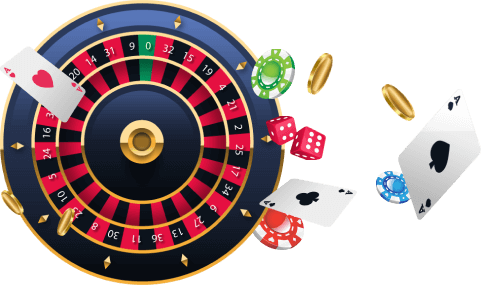Testing and Analyzing Fibonacci Strategy
Leonardo Pisano, who is better known as Fibonacci, was a brainy math nerd who made many observations during the 13th century. While he was famous for identifying various patterns in nature, he is best remembered for coming up with something called the Fibonacci sequence. This is a sequence of numbers in which each number adds up to the sum of the previous two numbers.
For example, if we start the sequence with zero and one, the next number would be the sum of zero plus one, which is one. The next number in the sequence would be the sum of one plus one, which is two. The next number would be three, which is the sum of one plus two. So, the sequence so far looks like this:
0, 1, 1, 2, 3
So, what do you think the next number would be? Well, when we add two and three together, we get five. Now we add three and five together to get eight. And on and on it goes.
We now fast forward about 500 years to the 18th century. It was then that another brainy math nerd named Blaise Pascal accidentally designed the first roulette wheel when he was trying to create a perpetual motion machine. Little did he know that roulette would live on in perpetuity.
The achievements of Fibonacci and Pascal would eventually cross paths. You see, astute roulette players started applying the Fibonacci sequence to roulette. In fact, the Fibonacci system is now one of the most popular roulette betting systems around. Let’s figure out how this strategy works.
How Does the Fibonacci Roulette System Work?
Let’s start by taking the first 10 numbers of the Fibonacci sequence. We have:
0, 1, 1, 2, 3, 5, 8, 13, 21, 34
Now, because we are using this sequence for betting, we will simply disregard the zero and first one, leaving us with:
1, 1, 2, 3, 5, 8, 13, 21, 34
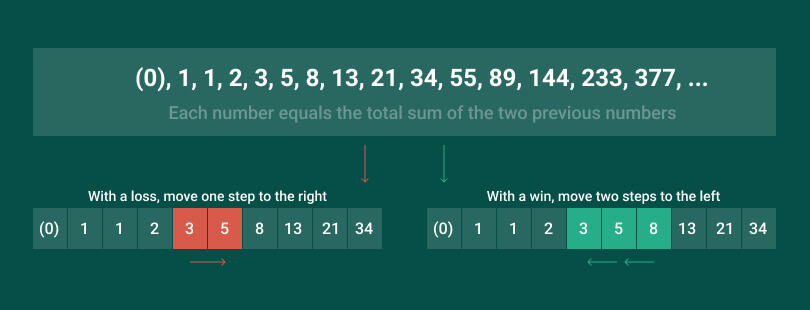
One of the key rules to this system is that it only applies to even money bets. For those unfamiliar with this term, these are the even-money roulette bets such as Red/Black, Odd/Even, and High/Low. We will start by betting $1, which is the first number in the sequence. To keep it simple, we will say that our bet loses. Accordingly, we again bet $1 to set the correct sequence. For example, this bet loses again. According to the system, we move up to the next number in the sequence for our third bet. This means we will wager $2. If that bet loses, then we go to the next number in the sequence, which is $3. Another loss would prompt us to up our bet to $5. Losing that bet would prompt us to increase the wager to $8. Each successive loss takes us to the next number in the Fibonacci sequence.
Let’s say that we place an $8 bet, and it wins. According to the system, we shift down two numbers. That would take us $3. If that bet wins, then we go down two more numbers which take us back to $1. If the $3 bet loses, we would simply go back up to the next number, which is $5. Let’s illustrate things by using the following fictitious results and a $1 bet base.
- Spin 1
Bet $1 and win our bet. We use the same $1 stake amount for the next bet to set the correct sequence.
- Spin 2
We lose the bet. The system calls for our next wager to be $2.
- Spin 3
We lose the bet. The system says we must wager $3 on the next round.
- Spin 4
We lose this one too. This means we stake $5 on the next one.
- Spin 5
We lose the bet. Time to up the wager to $8.
- Spin 6
We win this round. Now we lower our stake by two levels back to $3.
- Spin 7
Back to our losing ways. We once again increase the bet to $5.
- Spin 8
It’s a winner!! Now we lower the stake by two levels back to $2.
- Spin 9
We win again. We now go back to our $1 base stake.
Testing the Fibonacci System
To test this system, we used Google Sheets to generate the outcomes of 500 rounds of roulette. Losses and wins have probabilities of 52.4% and 48.6%, respectively, as per the house edge. For this experiment, we will use three players.
Next, using the JavaScript programming language, we simulated the course of the game according to the Fibonacci sequence while fixing the current bet amount and the bankroll state for each step. Based on the data obtained, graphs were constructed showing the change in the form of the bet and bankroll over time.
Results for the first player:
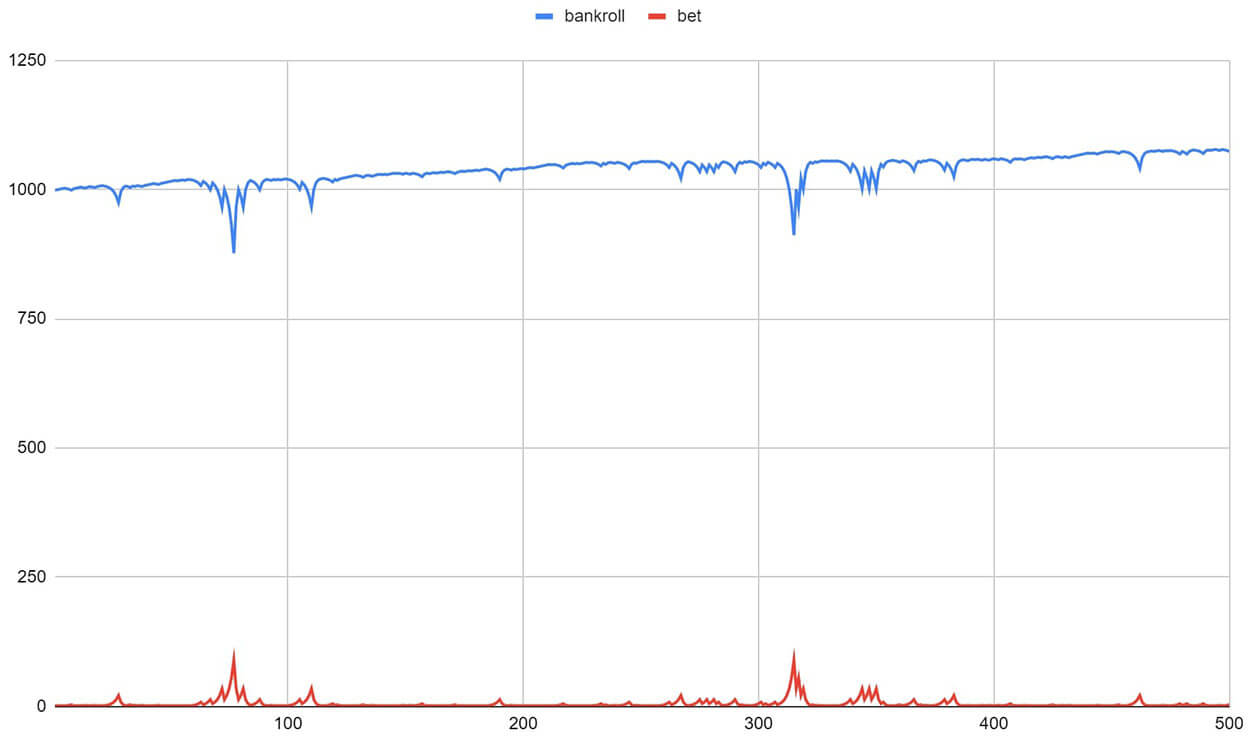
We see a barely noticeable growing progression. The player reached the maximum sequence bet of $89 two times. The low-point of the bankroll was $877 and, at the end of the game, the bankroll was $1074 for a total gain of $74
Now, let's see how the second player did:
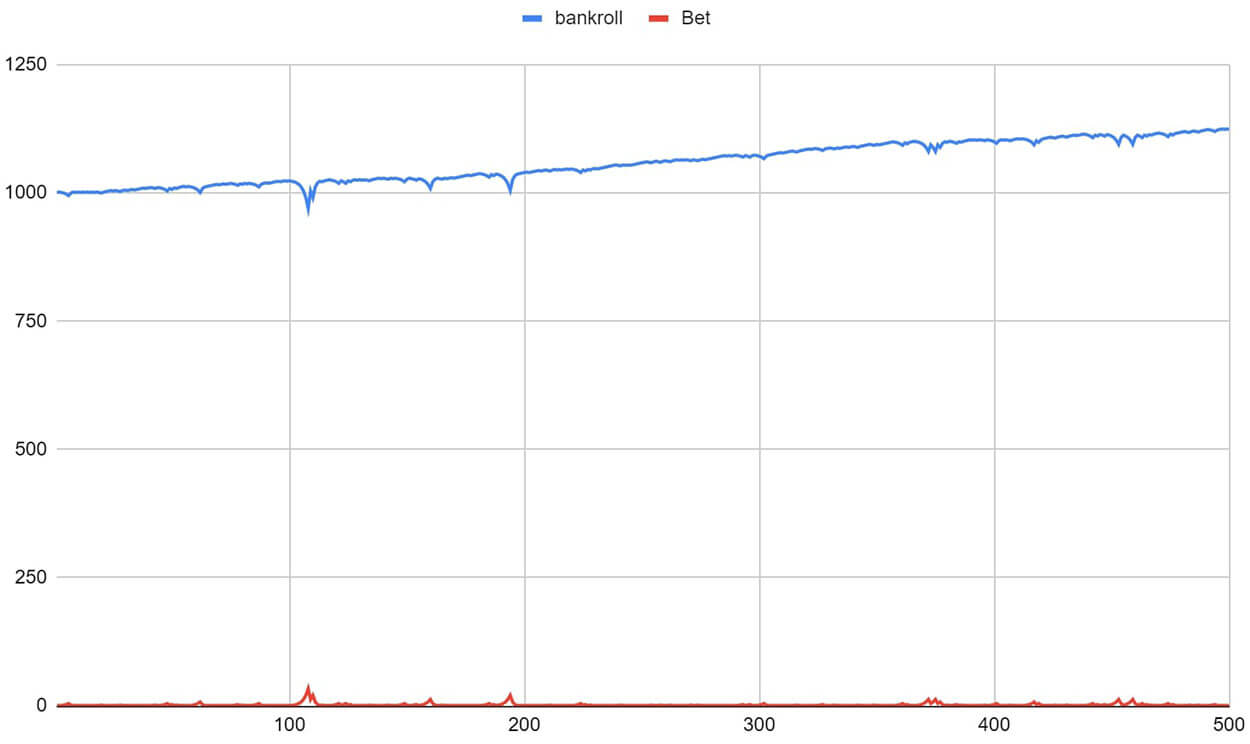
Just like with the previous player, we do not observe large drawdowns in the bankroll, and the player ends the session with $1124.
Results for the third player:
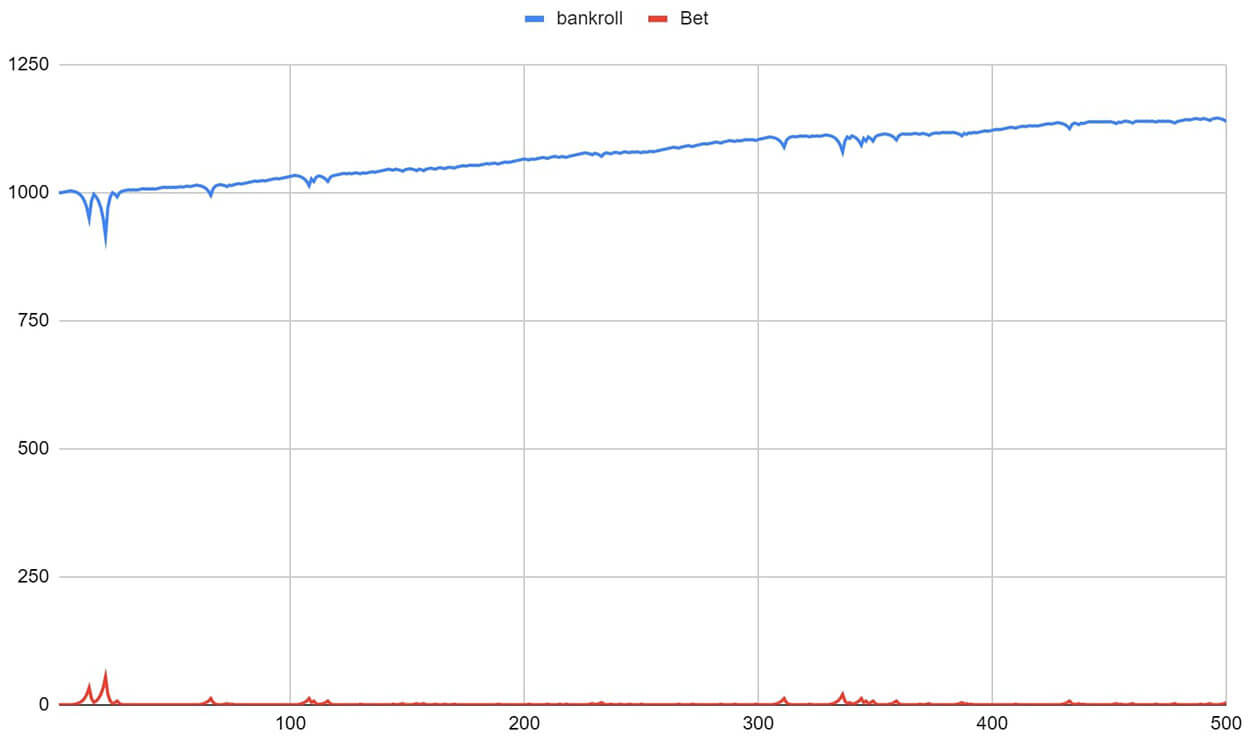
Again, no significant drawdowns and the player ended the game with a bankroll of $1139.
According to the results of the experiment, all 3 players who strictly followed the Fibonacci progression successfully completed their games with a profit. Any drawdowns in the bankroll were compensated by subsequent winning moves.
Theoretically, there could have been a progression deadlock due to going over the limits or a lack of bankroll, but this situation didn’t come close to happening. In this case, it would have taken 14 straight losses for lack of funds to be an issue.
| Bet | Status | Bankroll status |
|---|---|---|
| 1 | loss | 999 |
| 1 | loss | 998 |
| 2 | loss | 996 |
| 3 | loss | 993 |
| 5 | loss | 988 |
| 8 | loss | 980 |
| 13 | loss | 967 |
| 21 | loss | 946 |
| 34 | loss | 912 |
| 55 | loss | 857 |
| 89 | loss | 768 |
| 144 | loss | 624 |
| 233 | loss | 391 |
| 377 | loss | 14 |
The probability of such an outcome is equal to 0.524^14.
The Pitfalls of the Fibonacci System
Some sources falsely claim that the Fibonacci betting system is risky due to the possibility of rapid bankroll depletion and betting caps. This is not necessarily the case, as we see from the test. On the other hand, if you have a significantly smaller bankroll, hitting the cap can become a reality. For example, if you only have $100, you will be stuck if you suffer through eight consecutive losses. This potential drawback can be applied to almost every betting system.
This is a moderate progression system, and the risks here are minimal. The only obstacle that may arise is that it will take too much time to achieve at least some tangible profit in natural conditions, which can turn the game into a tedious process.
Conclusion
So, we tested the Fibonacci system on three players and charted the progress of their games. As you can see, due to the specifics of the algorithm, the bet size did not go too high. It reached a maximum of $89 for one of the players. After all, when we lose, we move up one step. When we win, we move two steps down, allowing us to keep the bet size relatively stable throughout the game.
Going beyond the permitted table limits is very unlikely, given that the bet limits on outside bets are often high. However, you should still pay attention to them as low-limit tables can restrict your maximum bet capability. Having an insufficient amount to compensate for losses is only possible if you have a small bankroll. Even if you have $100, then you can theoretically absorb eight consecutive losses, which would be a rare streak of bad luck.
When inventing his sequence, it is unlikely that Fibonacci expected that it would form the basis of a popular roulette strategy. Yes, getting a small plus over a long period is possible, but are you disciplined enough and financially capable of following the progression for a hundred turns or more? In general, the Fibonacci strategy is relatively safe. At least it’s safer than the popular Martingale system.
Your new strategy is waiting to be tested - play roulette for real!
-
1
 Wild Casino
Wild CasinoAccepts US players
Bonus 100% up to $5 000Wagering requirement x25Roulette games 10+Live dealerPayments -
-
2
 DuckyLuck
DuckyLuckAccepts US players
Bonus 500% up to $2 500Wagering requirement x30Roulette games 5Live dealerPayments -
-
3
 BetUS
BetUSAccepts US players
Bonus 100% up to $3 000Wagering requirement x30Roulette games 10+Live dealerPayments -
-
4
 Ignition Casino
Ignition CasinoAccepts US players
Bonus 100% up to $2 000Wagering requirement x25Roulette games 10+Live dealerPayments -
-
5
 BetOnline
BetOnlineAccepts US players
Bonus 100% up to $1 000Wagering requirement x30Roulette games 10+Live dealerPayments -
-
6
 Jackbit Casino
Jackbit CasinoAccepts US players
50 FreeSpins Welcome Casino BonusWagering requirement x1Roulette games 40+Live dealerPayments -
-
7
 SlotoCash
SlotoCashAccepts US players
Bonus 100% up to $1 000Wagering requirement x25Roulette games 5+Live dealerPayments -
-
8
 BoVegas
BoVegasAccepts US players
Bonus 100% up to $5 500Wagering requirement x60Roulette games 5+Live dealerPayments -
-
9
 Coinsgame
CoinsgameAccepts US players
Bonus 180% up to $20 000Wagering requirement x20Roulette games 10+Live dealerPayments -
-
10
 SlotsEmpire
SlotsEmpireAccepts US players
Bonus 245% Welcome offerWagering requirement x35Roulette games 5+Live dealerPayments -
-
11
 BC.Game
BC.GameAccepts US players
Bonus 180% up to $20 000Wagering requirement x40Roulette games 20+Live dealerPayments -
-
12
 Red Dog
Red DogAccepts US players
225% welcome bonus code: WAGGINGTAILSWagering requirement x35Roulette games 5+Live dealerPayments -
-
13
 Golden Lion
Golden LionAccepts US players
$75 Roulette Match code: TALISMAN75Wagering requirement x60Roulette games 5+Live dealerPayments -
-
14
 El Royale
El RoyaleAccepts US players
260% welcome bonus code: TRUEROYALWagering requirement x35Roulette games 5+Live dealerPayments -
Check out recommended articles for you
- Martingale Strategy
- Reverse Martingale
- Grand Martingale
- d'Alembert system
- Labouchere
- Romanovsky
- 666 system
- 36 system
- Oscar's Grind System
- Fisher system
- Contra Bet System
- 4567 system
- $150 system
- 24+8 system
- 64% system
- Hollandish system
- Tier et Tout
- Masse Egale
- Shotwell
- James Bond
- Safe strategies
- Strategies for american roulette
- Small Bankroll Strategies
- Live Roulette Strategies























